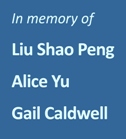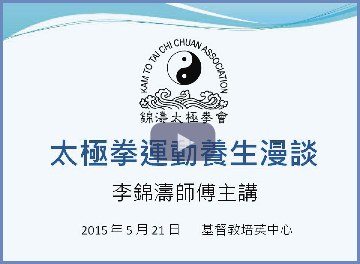

Tai Chi and Health
The material on this website does not constitute any form of medical advice or suggestion to treat any illness. It is intended for information purpose only. The practice of Tai Chi Chuan should be undertaken with the supervision of an experienced teacher. When practising on your own, please check with your instructor on a regular basis regarding posture accuracy as to avoid any injury.
- Tai Chi Chuan for Health (Sifu Laurens Lee)
- What is the Chinese Tai Chi Chuan? Of what value is it to mankind?
- Avoiding Knee Pain (Leo Leung)
- Tai Chi Chuan and Health (Leo Leung)
Tai Chi Chuan for Health - Sifu Laurens Lee
This is the video recording of the lecture "Tai Chi Chuan for Health" by Sifu Lee at the Pui Ying Christian Services Society on May 21, 2015. (Length: 87 minutes; Language: Cantonese)
What is the Chinese Tai Chi Chuan? Of what value is it to mankind?
When we learn Tai Chi Chuan, we must first understand what it is. Tai Chi Chuan is an exercise invented by early sages. It is a kind of exercise where heaven and man are united as one. It is a kind of exercise that scientifically nourishes life and philosophically preserves health. It is an excellent exercise that preserves health and vigour, prevents illness and prolongs life, suitable for the young and old in all walks of life. It is vastly different from any other form of exercise.
The majority of other forms of exercise have a bias towards certain sections of the body or the limbs. They use the brute force of the whole body, or summon forth in one breath all the turbid force of post-natal vitality in making a blind dash to win. The majority of them have as their object competition or the capture of prizes. After the exercise, one is drenched in sweat and pants excessively so that much harm is done to the body. As soon as one stops, one becomes very tired. It is said, “Excessive speed will harm the chi, excessive perseverance will harm the blood. When both chi and blood are harmed, then the health of the body will also suffer.” Take the case of most athletes who usually have to retire around the age of 30. Those forms of exercise are not suitable for the aged, the pregnant, and those with ailments.
Tai Chi Chuan is an exercise that combines the cosmos and nature as one body. It has yin and yang, and in it resilience there is strength. In its movements, it is completely in rhythm with the natural course of the universe. Its movements are continuous like the rise and fall of the waves in the ocean. The different parts of the body move together harmoniously. As it is said, “Motion and stillness have no beginning. The changes have no origin. Now void, now full, it is all very natural and beautiful.” Old and young, male and female, as well as the sick can all practice it. During the exercise, the whole body seems to sweat and yet the sweat does not flow. A flow of warmth emanates from the interior to the exterior, spreads all over the body and penetrates the very ends of the nerves. The skin on the whole body feels as though little insects are creeping all over it. The face feels as though it is covered by a spider’s web. After the exercise, one feels alert and comfortable, and one’s vigour is increased manifold. It is truly a great pleasure of life and elixir that rids one of illness and prolongs life.
The sages of ancient China founded this Tai Chi Chuan on the shape of the Tai Chi diagram, according to the “Li, Qi, Xiang” of the I-Ching. Chu Shi said, “All the changes within the boundaries of heaven and earth do not go beyond Li, Qi and Xiang”.
“Xiang” is form. i.e. the form of Tai Chi.
“Qi” is momentum. i.e. the method of Tai Chi.
“Li” is the profound principle. i.e. the merit and achievement of Tai Chi.
If the student first learns the form of Tai Chi, then understands the method of Tai Chi, and finally masters the principle of Tai Chi, he will find the way to preserve health and vigour, prevent illness and prolong life. According to the Tai Chi Diagram, its form is round. In the middle are the two Yin and Yang fish. Because of this, the external form of each movement in Tai Chi is rounded which is copied from Tai Chi. The two fish of Yin and Yang in the middle of the Tai Chi Diagram represent the two Yin and Yang “chi” of the universe. Yin is the resilient and Yang is the forceful, and these form the embryo from which is developed the use of the resilient and the forceful in Tai Chi Chuan.
Tai Chi was originally born of “Wu Ji” (emptiness). When the universe was first formed, everything was nebulous and undefined. This is called “Wu Ji”. From “Wu Ji” was born Tai Chi (the ultimate). From Tai Chi was born “Liang Yi” (two appearances), i.e. the Yin and the Yang. From “Liang Yi” was born “Si Xiang” (four forms), and from “Si Xiang” was born “BaGua” (eight diagrams). Within this are the five elements from which everything was born. The activity of growth and decline continues uninterrupted. That is why it is said, “Tai Chi is the original moving force of the entire universe, and Tai Chi Chuan was developed from this basic doctrine. During the process of achievement in Tai Chi, one starts from “Wu” (nothing) to “Yu” (something), and from “Yu” (something) to “Wu” (nothing). Its mystical powers now seem apparent and now seem unapparent. The strengths seem now to be present and now absent. One who achieves the acme of the art enters a mysterious realm. People are unable to anticipate the movements of your hands or make out the forms of your body. You advance and return with encircling movements that seem apparent and suddenly concealed. Unrestricted and unconventional, you achieve the state of self-forgetfulness. This is the Tai Chi Chuan that people aspire to.
Source: Tai Chi Chuan and Modern Lifestyles Conference booklet, 1996, pp.8-9.
Avoiding Knee Pain - Leo Leung
Years of active involvement in running, soccer, basketball, badminton and table tennis have caused my knees a great deal of wear and tear. The worsening condition persists because of my negligence and the absence of care. In order to alleviate my knee pain, I have resolved to participate intensely in Tai Chi and swimming. However, my friends attribute my knee problem to Tai Chi. Many beginner learners also experience knee discomfort after the first couple of lessons. As a result, they think that Tai Chi causes knee problems. This apparent cause and effect is not as straight forward as it seems and if not properly understood by learners, can result in their missing a great opportunity of learning and benefiting from Tai Chi.
There is always a chance of knee injury. Knee injury can occur when doing any type of sports, even Tai Chi when it is done improperly. One way that knees can be injured is when constant pressure is exerted. Under any circumstances, the knee, when flexed and pointed forward, should not exceed the tip of the toes. In normal circumstances, in order to alleviate the pressure on the knee joints, the weight of the body is transferred from the legs to the feet. However, in the Gungbu sitting position, if knees are over-bent, i.e. the knees caps are over the tip of the toes, the body weight will rest on the knees and cannot be transferred to the feet, thus causing unwanted pressure to be exerted on the knees.
Tai Chi Chuan has numerous pivoting movements. Another way that knees can be injured is not pivoting properly. In order to avoid injury, remember two things when you need to pivot your feet either inward or outward. Initially, it is important to shift your body weight first. For example, if you need to pivot your left foot, shift your weight to the right leg first, and your left foot will become free to move. Then, it is imperative that pivoting is synchronized with turning the torso. The torso steers the leg and the foot pivots at the same time. If they do not move simultaneously, knee injury can happen. The principle here is that knee joints can be flexed but not rotated.
In summary, remember that when bending your knees, align them behind the tip of your toes, and when pivoting either your left or right foot, shift your weight and let the torso do the pivoting. Knee pain should not occur if the above steps are followed properly.
Not only people who practise Tai Chi are prone to knee pain if they do not do it correctly. People who are overweight, bow-legged and pigeon-toed are also susceptible to knee pain. Pressure on the knees increases inward or outward as they walk or sit.
In any part of Tai Chi practice, whether doing the Gungbu position or turning from one direction to another, novices are reminded that the essence of Tai Chi is to be natural. Listen to your body and know its limits. Do not over-exert your muscles. Going with the flow of what your body tells you and proper practice will relegate the idea that Tai Chi causes knee pain to where it belongs – a misconception - thus allowing practitioners to engage fully in the pleasures of Tai Chi Chuan, a universally recognized activity conducive to good health.
Source: Herald Monthly, September 2008. Vancouver: Chinese Christian Herald Crusades (Canada). Original in Chinese, translated by Marian Yip & edited by Richard Sim.
Tai Chi Chuan and Health - Leo Leung
Recently Tai Chi Master Laurens Lee from British Columbia visited Toronto. Destiny brought us together and we had an open and congenial discussion on Tai Chi Chuan and health, topics that both of us are interested in. Master Lee has been promoting Tai Chi Chuan for many years and has accumulated a lot of valuable experience from the practice. Some examples are: students with Parkinson disease never fall down while practicing Tai Chi Chuan; students who are frail and have back pain improve physically gradually. Examples like these are far too many to mention. During our conversation, Master Lee cited a few points which are worth sharing:
- Practicing Tai chi Chuan improves the functioning of the pituitary gland;
- It is a very good spinal movement exercise. It can rotate your spine up to 360°. Human’s aging process starts from the feet. When you practice Tai Chi Chuan, concentrate on your ‘Yongquan’ (湧泉穴) (gushing spring). This helps your chi to flow from the feet to the whole body and slows down the aging process.
For beginners to understand better, I will try to explain how it works. The pituitary gland is a pea-sized gland that controls hormone secretion for the whole body. Recent research results from university medical schools in China have shown that Tai Chi Chuan benefits the endocrine system of the elderly, especially the pituitary gland. Even more interesting is that pituitary gland shares the same position with the upper dantian (上丹田), a point that is held in high importance in the traditional Chinese health movement (養生之道). What is the relationship between these two and are they the same? This needs further study.
The Vertebral column (spine) is the axial skeleton of the human body. Its functions include structural support, protection, flexibility and mobility, so appropriate spine exercise is very important. Tai Chi Chuan is “spine line boxing” (脊柱行拳).
First your head and neck should feel as if ‘suspended from above’, loosen your waist and cervix and lightly put your weight to the ground (emptiness and agility on the top, waist and spine power in the middle, and chi in the dantian down below). By applying bi-directional natural pulling force, it reduces bending of the S-Shape spine, and then through continuous rotation of the frame, it massages organs and meridians around the spine, thus reaching meridians, circulate the chi and achieve healing effect. ‘Mind focusing (意守)’ means concentrate on the activities.
‘Yongquan’ (湧泉) is one of the kidney meridian acupuncture points located slightly at the front part in the sole. When practicing Tai Chi Chuan, concentrating on your ‘Yongquan’ (湧泉) can make the chi move further down to the sole, and then throughout the whole body. This can slow down aging that starts from the extremities of the hands and feet. However, this practice is not suitable for people with low blood pressure. ‘Mind focusing’ is not emptiness of the mind, there is a material basis. The process of ‘thinking’ creates a thought wave. When you think of a certain part of your body, the capillaries will expand and more chi will flow to that part of the body. In Tai Chi Chuan, there is a principle of when the thought is there, the chi is there and the strength is there. That is the rationale for this principle. This is a physiological phenomenon. It is scientific and never take it as complication or mysterious.
Chinese culture has existed for thousands of years with numerous accumulated treasures. The correct attitude to develop it further is to approach it in a rational and scientific way.
Source: Herald Monthly, Eastern Canada edition, April 2013. Toronto: Chinese Christian Herald Crusades (Canada). Original in Chinese.
